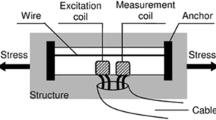Abstract
High-speed switching of current in gradient coils within high magnetic field strength magnetic resonance imaging (MRI) scanners results in high acoustic sound pressure levels (SPL) in and around these machines. To characterize the vibration properties as well as the acoustic noise properties of the gradient coil, a finite-element (FE) model was developed using the dimensional design specifications of an available gradient-coil insert and the concentration of the copper windings in the coil. This FE model was then validated using experimentally collected vibration data. A computational acoustic noise model was then developed based on the validated FE model. The validation of the finite-element analysis results was done using experimental modal testing of the same gradient coil in a free-free state (no boundary constraints). Based on the validated FE model, boundary conditions (supports) were added to the model to simulate the operating condition when the gradient-coil insert is in place in an MRI machine. Vibration analysis results from the FE model were again validated through experimental vibration testing with the gradient-coil insert installed in the MRI scanner and excited using swept sinusoidal time waveforms. The simulation results from the computational acoustic noise model were also validated through experimental noise measurement from the gradient-coil insert in the MRI scanner using swept sinusoidal time waveform inputs. Comparisons show that the FE model predicts the vibration properties and the computational acoustic noise model predicts the noise characteristic properties extremely accurately.
Similar content being viewed by others
References
Rutt BK (2003) Safety issues in MRI . Plenary address, In: The 11th scientific meeting of the international society for magnetic resonance in medicine, Toronto
Mechefske CK, Geris R, Gati JS, Rutt BK (2002) Acoustic noise reduction in a 4 T MRI scanner. Magn Reson Mater Phys Biol Med 13:172–176
Wu Y, Chronik BA, Bowen C, Mechefske CK, Rutt BK (2000) Gradient-induced acoustic and magnetic field fluctuation in a 4 T whole-body MR imager. Magn Reson Med 44:532–536
Hurwitz R, Lane SR, Bell RA, Brant-Zawadzki MN (1989) Acoustic analysis of gradient-coil noise in MR imaging. Radiology 173:545–548
Shellock FG, Morisoli SM, Ziarati M (1994) Measurement of acoustic noise during MR imaging: evaluation of six “worst-case” pulse sequences. Radiology 191:91–93
McJury MJ (1995) Acoustic noise levels generated during high field MR imaging. Clin Radiol 50:331–334
Counter SA, Olofsson A, Grahn A, Borg E (1997) MRI acoustic noise: sound pressure and frequency analysis. Magn Reson Imag 7:606–611
Price DL, DeWilde JP, Papadaki AM, Curran JS, Kitney RI (2001) Investigation of acoustic noise on 15 MRI scanners from 0.2 T to 3 T. Magn Reson Imag 13:288–293
Chapman BLW, Haywood B, Mansfield P (2003) Optimized gradient pulse for use with EPI employing active acoustic control. Magn Reson Med 50:931–935
Tomasi DG, Ernst T (2003) Echo planar imaging at 4 Tesla with minimum acoustic noise. J Magn Reson Imaging 18:128–130
Katsunuma A, Takamori H, Sakakura Y, Hamamura Y, Ogo Y, Katayama R (2002) Quiet MRI with novel acoustic noise reduction. Magn Reson Mater Phys Biol Med 13:139–144
Cho ZH, Chung ST, Chung JY (1998) A new silent magnetic resonance imaging using a rotating DC gradient. Magn Reson Med 39:317–321
Chen CK, Chiueh TD, Chen JH (1999) Active cancellation systems of acoustic noise in MR imaging. IEEE Trans. Biomed Eng 46:186–199
Edelstein WA, Hedeen RA, Mallozzi RP, El-Hamamsy SA, Ackermann RA, Havens TJ (2002) Making MRI Quieter. Magn Reson Imaging 20:155–163
Mansfield P, Haywood B, Coxon R (2001) Active acoustic control in gradient coils for MRI . Magn Reson Med 46:807–818
Mechefske CK, Wu Y, Rutt BK (2002) MRI gradient coil cylinder sound field simulation and measurement. J Biomech Eng 124:450–455
Mechefske CK, Wu Y, Rutt BK (2002) Characterization of acoustic noise and magnetic field fluctuations in a 4 T whole-body MRI scanner. Mech Syst Signal Process 16:459–473
Ling JX, Amor W, DeMeester G (1995) Numerical and experimental studies of the vibration and acoustic behaviors of MRI gradient tube. In: Proceedings of the acoustics, vibrations and rotating machines, ASME 1995, DE-vol 84(1). pp 311–317
Singhal RK, Guan W, Williams K (2002). Modal analysis of a thick-walled circular cylinder. Mech Syst Signal Process 16:141–153
Harris CM (1995) Shock and vibration handbook, 4th edn. McGraw Hill, New York
Li W, Mechefske CK, Rutt BK (2004) Acoustic noise analysis and prediction in a 4 T MRI scanner. Concepts in Magnetic Resonance, Part B: Magnetic Resonance Engineering 21B:19–25
Acknowledgements
The authors wish to offer special thanks to Andrew Alejski and Carl Gazdzinski at the Robarts Research Institute, London, Ontario, Canada for their kind help in providing the structural dimensions of the gradient-coil insert and setting up the vibration and noise measurement experiments. This work was funded through an NSERC-CIHR Collaborative Health Research Project grant (227285–9 CHRPJ) and an Ontario Research and Development Challenge Fund grant.
Author information
Authors and Affiliations
Corresponding author
Rights and permissions
About this article
Cite this article
Yao, G., Mechefske, C. & Rutt, B. Characterization of vibration and acoustic noise in a gradient-coil insert. MAGMA 17, 12–27 (2004). https://doi.org/10.1007/s10334-004-0041-0
Received:
Revised:
Accepted:
Published:
Issue Date:
DOI: https://doi.org/10.1007/s10334-004-0041-0




